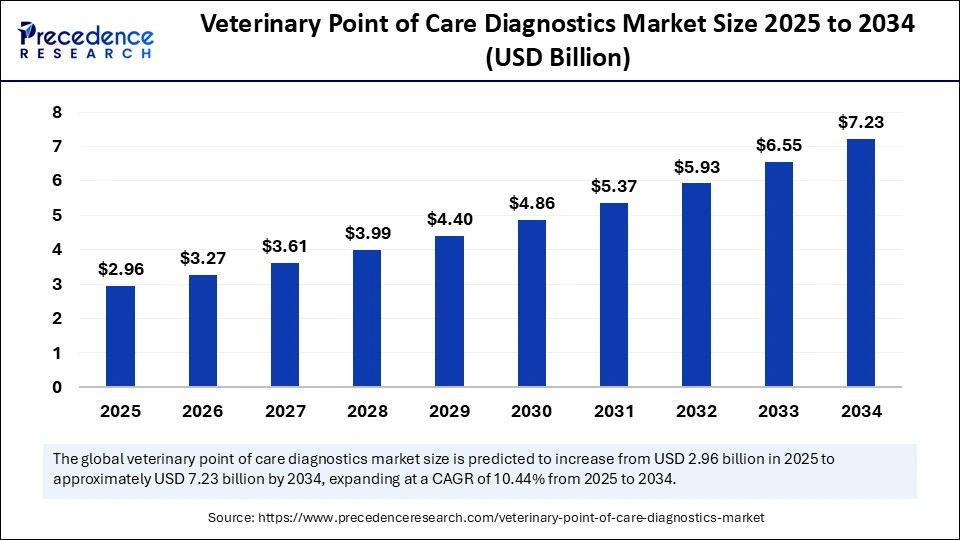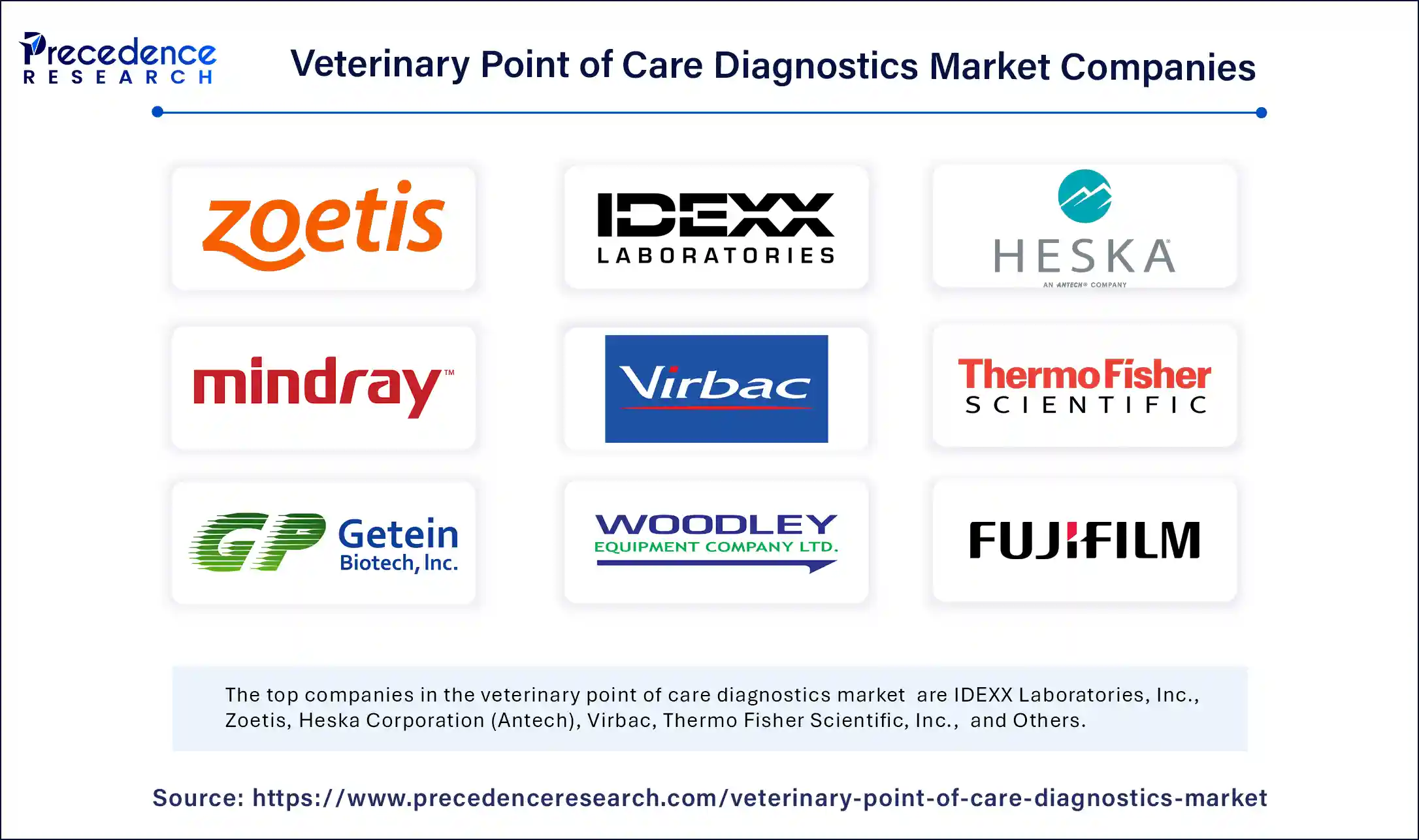Veterinary Point of Care (POC) diagnostics refers to rapid diagnostic testing tools used directly at the site of animal care — such as veterinary clinics, farms, or even in-field locations. These tests enable veterinarians to make immediate clinical decisions without sending samples to external laboratories. Common POC diagnostics include blood glucose monitors, urinalysis strips, immunoassay kits, and portable imaging systems.
Market Scope
| Report Coverage |
Details |
| Market Size by 2034 |
USD 7.23 Billion |
| Market Size in 2025 |
USD 2.96 Billion |
| Market Size in 2024 |
USD 2.68 Billion |
| Market Growth Rate from 2025 to 2034 |
CAGR of 10.44% |
| Dominating Region |
North America |
| Fastest Growing Region |
Asia Pacific |
| Base Year |
2024 |
| Forecast Period |
2025 to 2034 |
| Segments Covered |
Animal Type, Product, Testing Category, Sample Type, Indication, End-User and Region |
| Regions Covered |
North America, Europe, Asia-Pacific, Latin America, and Middle East & Africa |
Market Dynamics
Market Drivers
The veterinary point of care (PoC) diagnostics market is being driven by a confluence of technological, demographic, and economic factors. One of the primary drivers is the growing pet population worldwide, particularly in North America and Europe, where companion animals are often considered family members.
This trend is increasing demand for rapid, on-the-spot diagnostic tools that allow for timely disease detection and management. Furthermore, the rising incidence of zoonotic diseases and the growing awareness about animal health are pushing veterinary professionals to adopt PoC diagnostics to improve clinical outcomes. Technological advancements such as miniaturized devices, smartphone-based analyzers, and multiplexed testing systems are also propelling market growth.
Additionally, increasing veterinary healthcare expenditures and pet insurance adoption are enabling more frequent and advanced diagnostic testing, thereby supporting the market’s expansion.
Market Opportunities
The market presents robust opportunities driven by ongoing innovations and unmet needs in rural and resource-limited settings. One major opportunity lies in expanding access to veterinary care in remote and underserved regions, where traditional laboratory infrastructure is lacking. PoC diagnostics can enable quicker clinical decisions in the field, especially for livestock where timely diagnosis can prevent large-scale outbreaks.
Another area of opportunity is the integration of artificial intelligence (AI) and machine learning algorithms with PoC devices, which can enhance diagnostic accuracy and offer predictive insights. Startups and established players alike are exploring portable, app-based solutions that provide diagnostic results in real time, which is a key selling point for veterinarians and pet owners alike.
Moreover, increased investments in animal health infrastructure, particularly in developing countries, provide an untapped growth avenue for PoC technologies.
Market Challenges
Despite its promising outlook, the veterinary PoC diagnostics market faces several challenges. A major hurdle is the high cost of advanced diagnostic devices, which can limit adoption, especially among smaller veterinary clinics and in low-income regions. Another challenge is the lack of standardization and validation in some PoC products, which raises concerns about diagnostic accuracy and reliability.
Regulatory approval processes vary across regions, adding complexity for manufacturers aiming for global reach. Additionally, while technological advancements offer benefits, they also introduce challenges in terms of device complexity, maintenance, and the need for training veterinary personnel. Resistance to change among traditional veterinary practitioners, who may prefer lab-based diagnostics, further hinders market penetration.
Regional Outlook
Regionally, North America dominates the global veterinary PoC diagnostics market, holding the largest revenue share due to its well-established veterinary healthcare infrastructure, high pet ownership, and strong presence of leading market players. The U.S. in particular has witnessed widespread adoption of advanced PoC devices, driven by supportive regulatory policies and high veterinary expenditure.
Europe follows closely, with countries like Germany, the UK, and France emphasizing animal welfare and preventive healthcare, thereby fostering market growth. On the other hand, the Asia Pacific region is expected to grow at the fastest CAGR during the forecast period. Increasing pet adoption, rising disposable incomes, and improving veterinary care access in countries like China, India, and Australia are contributing to this surge.
Additionally, government initiatives for livestock disease control are fueling demand in rural agricultural communities. Meanwhile, Latin America and the Middle East & Africa are gradually emerging markets, where investment in veterinary services and mobile health solutions are opening new opportunities for PoC diagnostics.
Veterinary Point of Care Diagnostics Market Companies
Segments Covered in the Report
By Animal Type
- Companion Animals
- Livestock Animals
- Cattle
- Swine
- Poultry
- Others
By Product
- Consumables, Reagents, & Kits
- Instruments & Devices
By Testing Category
- Hematology
- Diagnostic Imaging
- Bacteriology
- Virology
- Cytology
- Clinical Chemistry
- Parasitology
- Serology
- Others
By Sample Type
- Infectious Disease
- General Ailments
- Others
By Indication
- Blood/Plasma/Serum
- Urine
- Fecal
- Others
By End-User
- Veterinary Hospitals & Clinics
- Home Care Settings
- Others
By Region
- North America
- Europe
- Asia Pacific
- Latin America
- Middle East and Africa (MEA)
Also Read: Ketamine Clinic Market
Get this report to explore global market size, share, CAGR, and trends, featuring detailed segmental analysis and an insightful competitive landscape overview @ https://www.precedenceresearch.com/sample/6187
You can place an order or ask any questions, please feel free to contact at sales@precedenceresearch.com|+1 804 441 9344

